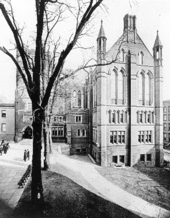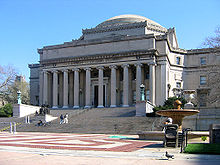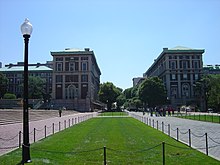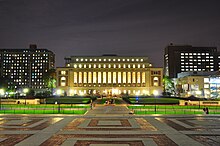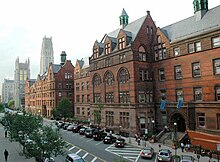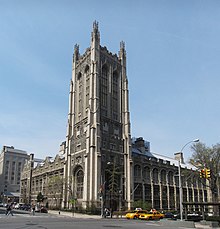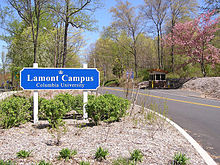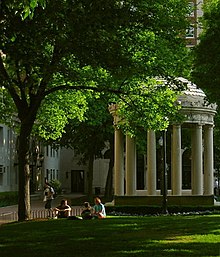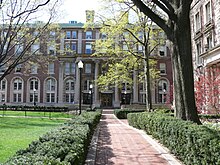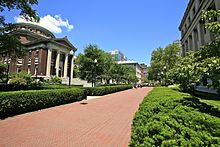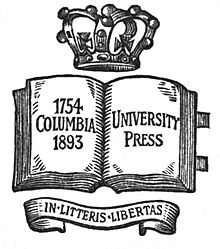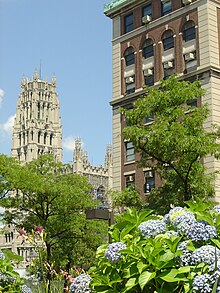Columbia University (officially Columbia University in the City of New York) is a private, Ivy League, research university in Upper Manhattan, New York City. It was established in 1754 as King's College by royal charter of George II of Great Britain. Columbia is the oldest college in New York State and the fifth chartered institution of higher learning in the country, making it one of nine colonial colleges founded before the Declaration of Independence. After the revolutionary war, King's College briefly became a state entity, and was renamed Columbia College in 1784. A 1787 charter placed the institution under a private board of trustees before it was renamed Columbia University in 1896 when the campus was moved from Madison Avenue to its current location in Morningside Heights occupying land of 32 acres (13 ha). Columbia is one of the fourteen founding members of the Association of American Universities, and was the first school in the United States to grant the M.D. degree.
The university is organized into twenty schools, including Columbia College, the School of Engineering and Applied Science, and theSchool of General Studies. The university also has global research outposts in Amman, Beijing, Istanbul, Paris, Mumbai, Rio de Janeiro, Santiago, Asunción and Nairobi. It has affiliations with several other institutions nearby, including Teachers College,Barnard College, and Union Theological Seminary, with joint undergraduate programs available through the Jewish Theological Seminary of America, Sciences Po Paris, and the Juilliard School.
Columbia annually administers the Pulitzer Prize. Notable alumni and former students (including those from King's College) include five Founding Fathers of the United States; nine Justices of the United States Supreme Court; 20 living billionaires; 29Academy Award winners;and 29 heads of state, including three United States Presidents. Additionally, some 100 Nobel laureates have been affiliated with Columbia as students, faculty, or staff, second in the world only to Harvard.
Contents
History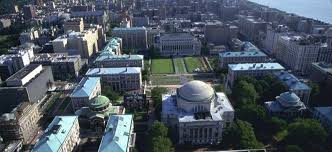
Main article: History of Columbia University
King's College (1754–1784)
Discussions regarding the founding of a college in the Province of New York began as early as 1704, at which time Colonel Lewis Morriswrote to the Society for the Propagation of the Gospel in Foreign Parts, the missionary arm of the Church of England, persuading the society that New York City was an ideal community in which to establish a college; however, not until the founding of Princeton University across the Hudson River in New Jersey did the City of New York seriously consider founding a college. In 1746 an act was passed by the general assembly of New York to raise funds for the foundation of a new college. In 1751, the assembly appointed a commission of ten New York residents, seven of whom were members of the Church of England, to direct the funds accrued by the state lottery towards the foundation of a college.
Classes were initially held in July 1754 and were presided over by the college's first president, Dr. Samuel Johnson. Dr. Johnson was the only instructor of the college's first class, which consisted of a mere eight students. Instruction was held in a new schoolhouse adjoining Trinity Church, located on what is now lower Broadway in Manhattan. The college was officially founded on October 31, 1754, as King's College by royal charter ofKing George II, making it the oldest institution of higher learning in the state of New York and the fifth oldest in the United States.
In 1763, Dr. Johnson was succeeded in the presidency by Myles Cooper, a graduate of The Queen's College, Oxford, and an ardent Tory. In the charged political climate of theAmerican Revolution, his chief opponent in discussions at the college was an undergraduate of the class of 1777, Alexander Hamilton. The American Revolutionary War broke out in 1776, and was catastrophic for the operation of King's College, which suspended instruction for eight years beginning in 1776 with the arrival of the Continental Army. The suspension continued through the military occupation of New York City by British troops until their departure in 1783. The college's library was looted and its sole building requisitioned for use as a military hospital first by American and then British forces. Loyalists were forced to abandon their King's College in New York, which was seized by the rebels and renamed Columbia College. The Loyalists, led by Bishop Charles Inglis fled to Windsor, Nova Scotia, where they founded King's Collegiate School.
Columbia College (1784–1896)
After the Revolution, the college turned to the State of New York in order to restore its vitality, promising to make whatever changes to the school's charter the state might demand. The Legislature agreed to assist the college, and on May 1, 1784, it passed "an Act for granting certain privileges to the College heretofore called King's College." The Act created a Board of Regents to oversee the resuscitation of King's College, and, in an effort to demonstrate its support for the new Republic, the Legislature stipulated that "the College within the City of New York heretofore called King's College be forever hereafter called and known by the name of Columbia College," a reference to Columbia, an alternative name for America. The Regents finally became aware of the college's defective constitution in February 1787 and appointed a revision committee, which was headed by John Jay and Alexander Hamilton. In April of that same year, a new charter was adopted for the college, still in use today, granting power to a private board of 24 Trustees.
On May 21, 1787, William Samuel Johnson, the son of Dr. Samuel Johnson, was unanimously elected President of Columbia College. Prior to serving at the university, Johnson had participated in the First Continental Congress and been chosen as a delegate to the Constitutional Convention. For a period in the 1790s, with New York City as the federal and state capital and the country under successive Federalistgovernments, a revived Columbia thrived under the auspices of Federalists such as Hamilton and Jay. Both President George Washington and Vice President John Adams attended the college's commencement on May 6, 1789, as a tribute of honor to the many alumni of the school who had been involved in the American Revolution.
The college's enrollment, structure, and academics stagnated for the majority of the 19th century, with many of the college presidents doing little to change the way that the college functioned. In 1857, the college moved from Park Place to a primarily Gothic Revivalcampus on 49th Street and Madison Avenue, where it remained for the next fifty years. During the last half of the 19th century, under the leadership of President F.A.P. Barnard, the institution rapidly assumed the shape of a modern university.By this time, the college's investments in New York real estate became a primary source of steady income for the school, mainly owing to the city's expanding population.
Columbia University (1896–present)
In 1896, the trustees officially authorized the use of yet another new name, Columbia University, and today the institution is officially known as "Columbia University in the City of New York." At the same time, university president Seth Low moved the campus again, from 49th Street to its present location, a more spacious campus in the developing neighborhood of Morningside Heights. Under the leadership of Low's successor,Nicholas Murray Butler, who served for over four decades, Columbia rapidly became the nation's major institution for research, setting the "multiversity" model that later universities would adopt.
Research into the atom by faculty members John R. Dunning, I. I. Rabi, Enrico Fermi and Polykarp Kusch placed Columbia's Physics Department in the international spotlight in the 1940s after the first nuclear pile was built to start what became the Manhattan Project. In 1947, to meet the needs of GIs returning from World War II, University Extension was reorganized as an undergraduate college and designated the Columbia University School of General Studies.
During the 1960s Columbia experienced large-scale student activism, which reached a climax in the spring of 1968 when hundreds of students occupied buildings on campus. The incident forced the resignation of Columbia's President, Grayson Kirk and the establishment of the University Senate.
Though several schools within the university had admitted women for years, Columbia College first admitted women in the fall of 1983, after a decade of failed negotiations with Barnard College, the all-female institution affiliated with the university, to merge the two schools. Barnard College still remains affiliated with Columbia, and all Barnard graduates are issued diplomas authorized by both Columbia University and Barnard College.
Campus
Along with NYU and the Catholic Church, Columbia University is one of the top 3 largest landowners in New York City.
Morningside Heights
The majority of Columbia's graduate and undergraduate studies are conducted in Morningside Heights on Seth Low's late-19th century vision of a university campus where all disciplines could be taught in one location. The campus was designed along Beaux-Arts principles by architects McKim, Mead, and White. Columbia's main campus occupies more than six city blocks, or 32 acres (13 ha), in Morningside Heights, New York City, a neighborhood that contains a number of academic institutions. The university owns over 7,800 apartments in Morningside Heights, housing faculty, graduate students, and staff. Almost two dozen undergraduate dormitories (purpose-built or converted) are located on campus or in Morningside Heights. Columbia University has an extensive underground tunnel system more than a century old, with the oldest portions predating the present campus. Some of these remain accessible to the public, while others have been cordoned off.
The Nicholas Murray Butler Library, commonly known simply as Butler Library, is the largest single library in the Columbia University Library System, and is one of the largest buildings on the campus. Proposed as "South Hall" by the university's former President Nicholas Murray Butler as expansion plans for Low Memorial Library stalled, the new library was funded by Edward Harkness, benefactor of Yale's residential college system, and designed by his favorite architect, James Gamble Rogers. It was completed in 1934 and renamed for Butler in 1946. The library design is neo-classical in style. Its facade features an arcade of columns in the Ionic order above which are inscribed the names of great writers, philosophers, and thinkers, most of whom are read by students engaged in the Core Curriculum of Columbia College. As of 2012, Columbia's library system includes over 11.9 million volumes, making it the eighth largest library system and fifth largest collegiate library system in the United States.It has also been ranked among the United States' most beautiful libraries.
Several buildings on the Morningside Heights campus are listed on the National Register of Historic Places. Low Memorial Library, aNational Historic Landmark and the centerpiece of the campus, is listed for its architectural significance. Philosophy Hall is listed as the site of the invention of FM radio. Also listed is Pupin Hall, another National Historic Landmark, which houses the physics and astronomy departments. Here the first experiments on the fission of uranium were conducted by Enrico Fermi. The uranium atom was split there ten days after the world's first atom-splitting in Copenhagen, Denmark.
A statue by sculptor Daniel Chester French called Alma Mater is centered on the front steps ofLow Memorial Library. McKim, Mead & White invited French to build the sculpture in order to harmonize with the larger composition of the court and library in the center of the campus. Draped in an academic gown, the female figure of Alma Mater wears a crown of laurels and sits on a throne. The scroll-like arms of the throne end in lamps, representing sapientia and doctrina. A book signifying knowledge, balances on her lap, and an owl, the attribute of wisdom, is hidden in the folds of her gown. Her right hand holds a scepter composed of four sprays of wheat, terminating with a crown of King's College which refers to Columbia's origin as a Royalist institution in 1754. A local actress named Mary Lawton was said to have posed for parts of the sculpture. The statue was dedicated on September 23, 1903, as a gift of Mr. & Mrs. Robert Goelet, and was originally covered in golden leaf. During the Columbia University protests of 1968 a bomb damaged the sculpture, but it has since been repaired.The small hidden owl on the sculpture is also the subject of many Columbia legends, the main legend being that the first student in the freshmen class to find the hidden owl on the statue will be valedictorian, and that any subsequent Columbia male who finds it will marry a Barnard student, given that Barnard is awomen's college.
"The Steps", alternatively known as "Low Steps" or the "Urban Beach", are a popular meeting area for Columbia students. The term refers to the long series of granite steps leading from the lower part of campus (South Field) to its upper terrace. With a design inspired by the City Beautiful movement, the steps of Low Library provides Columbia University and Barnard College students, faculty, and staff with a comfortable outdoor platform and space for informal gatherings, events, and ceremonies. McKim's classical facade epitomizes late 19th century new-classical designs, with its columns and portico marking the entrance to an important structure.] On warm days when the weather is favorable, the Low Steps often become a popular gathering place for students to sunbathe, eat lunch, or play frisbee.
Other campuses
In April 2007, the university purchased more than two-thirds of a 17 acres (6.9 ha) site for a new campus in Manhattanville, an industrial neighborhood to the north of the Morningside Heights campus. Stretching from 125th Street to 133rd Street, the new campus will house buildings for Columbia's Business School, School of International and Public Affairs, and the Jerome L. Greene Center for Mind, Brain, and Behavior, where research will occur on neurodegenerative diseases such as Parkinson's and Alzheimer's.The $7 billion expansion plan includes demolishing all buildings, except three that are historically significant, eliminating the existing light industry and storage warehouses, and relocating tenants in 132 apartments. Replacing these buildings will be 6,800,000 square feet (630,000 m2) of space for the university. Community activist groups in West Harlem fought the expansion for reasons ranging from property protection and fair exchange for land, to residents' rights. Subsequent public hearings drew neighborhood opposition. Most recently, as of December 2008, the State of New York's Empire State Development Corporation approved use of eminent domain, which, through declaration of Manhattanville's "blighted" status, gives governmental bodies the right to appropriate private property for public use. On May 20, 2009, the New York State Public Authorities Control Board approved the Manhanttanville expansion plan and the first buildings are under construction.
New York-Presbyterian Hospital is affiliated with the medical schools of both Columbia University and Cornell University. According to U.S. News & World Report's "America's Best Hospitals 2009", it is ranked sixth overall and third among university hospitals. Columbia's medical school has a strategic partnership with New York State Psychiatric Institute, and is affiliated with 19 other hospitals in the U.S. and four hospitals overseas. Health-related schools are located at the Columbia University Medical Center, a 20 acres (8.1 ha) campus located in the neighborhood of Washington Heights, fifty blocks uptown. Other teaching hospitals affiliated with Columbia through the New York-Presbyterian network include the Payne Whitney Clinic in Manhattan, and the Payne Whitney Westchester, a psychiatric institute located in White Plains, New York.On the northern tip of Manhattan island (in the neighborhood of Inwood), Columbia owns 26-acre (11 ha) Baker Field, which includes the Lawrence A. Wien Stadium as well as facilities for field sports, outdoor track, and tennis. There is a third campus on the west bank of the Hudson River, the 157-acre (64 ha) Lamont-Doherty Earth Observatory and Earth Institute in Palisades, New York. A fourth is the 60-acre (24 ha) Nevis Laboratories in Irvington, New York for the study of particle and motion physics. A satellite site in Paris, France holds classes atReid Hall.
Sustainability
In 2006, the university established the Office of Environmental Stewardship to initiate, coordinate and implement programs to reduce the university's environmental footprint. The U.S. Green Building Council selected the university's Manhattanville plan for the Leadership in Energy and Environmental Design (LEED) Neighborhood Design pilot program. The plan commits to incorporating smart growth, new urbanism and "green" building design principles.Columbia is one of the 2030 Challenge Partners, a group of nine universities in the city of New York that have pledged to reduce their greenhouse emissions by 30% within the next ten years. Columbia University adopts LEED standards for all new construction and major renovations. The University requires a minimum of Silver, but through its design and review process seeks to achieve higher levels. This is especially challenging for lab and research buildings with their intensive energy use; however, the university also uses lab design guidelines that seek to maximize energy efficiency while protecting the safety of researchers.
Every Thursday and Sunday of the month, Columbia hosts a greenmarket where local farmers can sell their produce to residents of the city. In addition, from April to November Hodgson's farm, a local New York gardening center, joins the market bringing a large selection of plants and blooming flowers. The market is one of the many operated at different points throughout the city by the non-profit group GrowNYC. Dining services at Columbia spends 36 percent of its food budget on local products, in addition to serving sustainably harvested seafood and fair trade coffee on campus.Columbia has been rated "B+" by the 2011 College Sustainability Report Card for its environmental and sustainability initiatives.
Academics
Undergraduate admissions and financial aid
Columbia University's acceptance rate for the class of 2020 (Columbia College and Engineering) was 6.04%, making Columbia the third most selective college in the United States by admission rate behind Stanford and Harvard. The undergraduate yield rate for the class of 2019 was 63.2%. According to the 2012 college selectivity ranking by U.S. News & World Report, which factors admission and yield rates among other criteria, Columbia was tied with Yale, Caltech and MIT as the most selective colleges in the country.Columbia is a racially diverse school, with approximately 52% of all students identifying themselves as persons of color. Additionally, 50% of all undergraduates received grants from Columbia. The average grant size awarded to these students is $46,516. In 2015-2016, annual undergraduate tuition at Columbia was $50,526 with a total cost of attendance of $65,860 (including room and board).
On April 11, 2007, Columbia University announced a $400m to $600m donation from media billionaire alumnus John Kluge to be used exclusively for undergraduate financial aid. The donation is among the largest single gifts to higher education. Its exact value will depend on the eventual value of Kluge's estate at the time of his death; however, the generous donation has helped change financial aid policy at Columbia.Annual gifts, fund-raising, and an increase in spending from the university's endowment have allowed Columbia to extend generous financial aid packages to qualifying students. As of 2008, undergraduates from families with incomes as high as $60,000 a year will have the projected cost of attending the university, including room, board, and academic fees, fully paid for by the university. That same year, the university ended loans for incoming and current students who were on financial aid, replacing loans that were traditionally part of aid packages with grants from the university. However, this does not apply to international students, transfer students, visiting students, or students in the School of General Studies.In the fall of 2010, admission to Columbia's undergraduate colleges Columbia College and the Fu Foundation School of Engineering and Applied Science (also known as SEAS or Columbia Engineering) began accepting the Common Application. The policy change made Columbia one of the last major academic institutions and the last Ivy Leagueuniversity to switch to the Common Application.
Scholarships are also given to undergraduate students by the admissions committee. Designations include John W. Kluge Scholars, John Jay Scholars, C. Prescott Davis Scholars, Global Scholars, Egleston Scholars, and Science Research Fellows. Named scholars are selected by the admission committee from first-year applicants. According to Columbia, the first four designated scholars "distinguish themselves for their remarkable academic and personal achievements, dynamism, intellectual curiosity, the originality and independence of their thinking, and the diversity that stems from their different cultures and their varied educational experiences."
Organization
| Columbia Graduate/Professional Schools | |
|---|---|
| College/school | Year founded |
| ---- | |
| College of Physicians and Surgeons | 1767 |
| Union Theological Seminary | 1836 |
| College of Dental Medicine | 1852 |
| Columbia Law School | 1858 |
| Fu Foundation School of Engineering and Applied Science | 1864 |
| Graduate School of Arts and Sciences | 1880 |
| Graduate School of Architecture, Planning and Preservation | 1881 |
| Teachers College, Columbia University | 1889 |
| Columbia University School of Nursing | 1892 |
| Columbia University School of Social Work | 1898 |
| Graduate School of Journalism | 1912 |
| Columbia Business School | 1916 |
| Mailman School of Public Health | 1922 |
| School of International and Public Affairs | 1946 |
| School of General Studies | 1947 |
| The School of the Arts | 1948 |
| Columbia University's School of Professional Studies | 1995 |
Columbia University is an independent, privately supported, nonsectarian institution of higher education. Its official corporate name is "The Trustees of Columbia University in the City of New York." The university's first Charter was granted in 1754 by King George II; however, its modern Charter was first enacted in 1787 and last amended in 1810 by the New York State Legislature. The university is governed by 24 Trustees, customarily including the President, who serves ex officio. The Trustees themselves are responsible for choosing their successors. Six of the 24 are nominated from a pool of candidates recommended by the Columbia Alumni Association. Another six are nominated by the Board in consultation with the Executive Committee of the University Senate. The remaining 12, including the President, are nominated by the Trustees themselves through their internal processes. The term of office for Trustees is six years. Generally, they serve for no more than two consecutive terms. The Trustees appoint the President and other senior administrative officers of the university, and review and confirm faculty appointments as required. They determine the university's financial and investment policies, authorize the budget, supervise the endowment, direct the management of the university's real estate and other assets, and otherwise oversee the administration and management of the university.
The University Senate was established by the Trustees after a university-wide referendum in 1969. It succeeded to the powers of the University Council, which was created in 1890 as a body of faculty, deans, and other administrators to regulate inter-Faculty affairs and consider issues of university-wide concern. The University Senate is a unicameral body consisting of 107 members drawn from all constituencies of the university. These include the president of the university, the Provost, the Deans of Columbia College and the Graduate School of Arts and Sciences, all who serve ex officio, and five additional representatives, appointed by the President, from the university's administration. The President serves as the Senate's presiding officer. The Senate is charged with reviewing the educational policies, physical development, budget, and external relations of the university. It oversees the welfare and academic freedom of the faculty and the welfare of students.
The President of Columbia University, who is selected by the Trustees in consultation with the Executive Committee of the University Senate and who serves at the Trustees' pleasure, is the chief executive officer of the university. Assisting the President in administering the University are the Provost, the Senior Executive Vice President, the Executive Vice President for Health and Biomedical Sciences, several other vice presidents, the General Counsel, the Secretary of the University, and the deans of the Faculties, all of whom are appointed by the Trustees on the nomination of the President and serve at their pleasure.Lee C. Bollinger became the 19th President of Columbia University on June 1, 2002. A prominent advocate of affirmative action, he played a leading role in the twin Supreme Court cases—Grutter v Bollinger and Gratz v Bollinger—that upheld and clarified the importance of diversity as a compelling justification for affirmative action in higher education. A leading First Amendment scholar, he is widely published on freedom of speech and press, and serves on the faculty of Columbia Law School.
Columbia has three official undergraduate colleges: Columbia College (CC), the liberal arts college offering the Bachelor of Arts degree, the Fu Foundation School of Engineering and Applied Science (also known as SEAS or Columbia Engineering) is the engineering and applied science school offering the Bachelor of Science degree, and The School of General Studies (GS), the liberal arts college offering the Bachelor of Arts degree to non-traditional students undertaking full- or part-time study.The university is affiliated withTeachers College, Barnard College, and Union Theological Seminary, all located nearby in Morningside Heights. Joint undergraduate programs are available through the Jewish Theological Seminary of America as well as through the Juilliard School. Affiliated institutions – Barnard College, Teachers College, and Union Theological Seminary – are also Faculties of the university.One affiliated institution—Teachers College—is likewise an academic department of the university.
Research and rankings
| ||||||||||||||||||||
Columbia was the first North American site where the uranium atom was split. It was the birthplace of FM radio and the laser.TheMPEG-2 algorithm of transmitting high quality audio and video over limited bandwidth was developed by Dimitris Anastassiou, a Columbia professor of electrical engineering. Biologist Martin Chalfie was the first to introduce the use of Green Fluorescent Protein(GFP) in labeling cells in intact organisms. Other inventions and products related to Columbia include Sequential Lateral Solidification (SLS) technology for making LCDs, System Management Arts (SMARTS), Session Initiation Protocol (SIP) (which is used for audio, video, chat, instant messaging and whiteboarding), pharmacopeia, Macromodel (software for computational chemistry), a new and better recipe for glass concrete, Blue LEDs, and Beamprop (used in photonics). Columbia scientists have been credited with about 175 new inventions in the health sciences each year.More than 30 pharmaceutical products based on discoveries and inventions made at Columbia are on the market today. These include Remicade (for arthritis), Reopro (for blood clot complications), Xalatan (for glaucoma), Benefix, Latanoprost (a glaucoma treatment), shoulder prosthesis, homocysteine (testing for cardiovascular disease), and Zolinza (for cancer therapy).Columbia Technology Ventures (formerly Science and Technology Ventures), as of 2008, manages some 600 patents and more than 250 active license agreements.Patent-related deals earned Columbia more than $230 million in the 2006 fiscal year, according to the university, more than any university in the world.
Columbia University was ranked 4th overall among U.S. national universities for 2016 by U.S. News & World Report. Individual colleges and schools were also nationally ranked by U.S. News & World Report for its 2016 edition. The Columbia Law School was ranked tied for 4th, the Mailman School of Public Health 5th, the School of Social Work 5th, the Teachers College(Columbia Graduate School of Education) 7th, the Columbia Business School 8th, theCollege of Physicians and Surgeons tied for 8th for research (and tied for 52nd for primary care), the Graduate School of Arts 10th, the School of Nursing tied for 11th, and the Fu Foundation School of Engineering and Applied Science (graduate) was ranked 14th.
In 2015, Columbia was ranked 8th in the world by Academic Ranking of World Universities,22nd in the world by QS World University Rankings, and 15th globally by Times Higher Education World University Rankings in the world.
Rankings by other organizations include the Graduate School of Architecture, Planning and Preservation #2, and its Graduate School of Journalism #1.
Between 1996 and 2008, 18 Columbia affiliates have won Nobel Prizes, of whom nine are faculty members while one is an adjunct senior research scientist (Daniel Tsui) and the other a Global Fellow (Kofi Annan). Columbia faculty awarded the Nobel Prize include Richard Axel, Martin Chalfie, Eric Kandel, Tsung-Dao Lee, Robert Mundell,Orhan Pamuk, Edmund S. Phelps, Joseph Stiglitz, and Horst L. Stormer. Other awards and honors won by faculty include 30 MacArthur Foundation Award winners, 4National Medal of Science recipients, 43 National Academy of Sciences Award winners,20 National Academy of Engineering Award winners,38 Institute of Medicine of the National Academies Award recipients and 143 American Academy of Arts and Sciences Award winners.
In 2015, Columbia University was ranked the first in the state by average professor salaries.In 2011, the Mines ParisTech : Professional Ranking World Universities ranked Columbia 3rd best university for forming CEOs in the US and 12th worldwide.
Student life
Students
| Undergraduate | Postgraduate | ||
|---|---|---|---|
| Asian/Pacific Islander | 17.1% | 10.9% | |
| Black | 7.2% | 4.1% | |
| Hispanic | 12.8% | 5.7% | |
| American Indian/Alaskan Native | 0.5% | 0.1% | |
| Two or more races | 4.7% | 1.7% | |
| White | 38.1% | 32.6% | |
| Non-resident Aliens | 13.4% | 34.3% | |
| Unknown | 6.2% | 10.5% |
In fall 2014, Columbia University's student population was 29,870 (8,559 students in undergraduate programs and 21,311 in postgraduate programs), with 39% of the student population identifying themselves as a minority and 28% born outside of the United States. Twenty-six % of students at Columbia have family incomes below $60,000, making it one of the most socioeconomically diverse top-tier colleges.Sixteen % of students at Columbia receive Federal Pell Grants, which mostly go to students whose family incomes are below $40,000. Fifteen % of students are the first member of their family to attend a four-year college.
On-campus housing is guaranteed for all four years as an undergraduate. Columbia College and the Fu Foundation School of Engineering and Applied Science (also known as SEAS or Columbia Engineering) share housing in the on-campus residence halls. First-year students usually live in one of the large residence halls situated around South Lawn: Hartley Hall, Wallach Hall (originally Livingston Hall), John Jay Hall, Furnald Hall or Carman Hall. Upperclassmen participate in a room selection process, wherein students can pick to live in a mix of either corridor- or apartment-style housing with their friends. The Columbia University School of General Studies and graduate schools have their own apartment-style housing in the surrounding neighborhood.
Columbia University is home to many fraternities, sororities, and co-educational Greek organizations. Approximately 10–15% of undergraduate students are associated with Greek life.There has been a Greek presence on campus since the establishment in 1836 of the Delta Chapter of Alpha Delta Phi. The InterGreek Council is the self-governing student organization that provides guidelines and support to its member organizations within each of the three councils at Columbia, the Interfraternity Council, Panhellenic Council, and Multicultural Greek Council. The three council presidents bring their affiliated chapters together once a month to meet as one Greek community. The InterGreek Council meetings provide opportunity for member organizations to learn from each other, work together and advocate for community needs.
Publications
Columbia University is home to a rich diversity of undergraduate, graduate, and professional publications. The Columbia Daily Spectator is the nation's second-oldest student newspaper;and The Blue and White, a monthly literary magazine established in 1890, has recently begun to delve into campus life and local politics in print and on its daily blog, dubbed the Bwog.
Political publications include The Current,a journal of politics, culture and Jewish Affairs; the Columbia Political Review, the multi-partisan political magazine of the Columbia Political Union; and AdHoc, which denotes itself as the "progressive" campus magazine and deals largely with local political issues and arts events.
Arts and literary publications include the Columbia Review, the nation's oldest college literary magazine; Columbia, a nationally regarded literary journal; the Columbia Journal of Literary Criticism; and The Mobius Strip, an online arts and literary magazine.Inside New York is an annual guidebook to New York City, written, edited, and published by Columbia undergraduates. Through a distribution agreement with Columbia University Press, the book is sold at major retailers and independent bookstores.
Columbia is home to numerous undergraduate academic publications. The Journal of Politics & Society, is a journal of undergraduate research in the social sciences, published and distributed nationally by the Helvidius Group; Publius is an undergraduate journal of politics established in 2008 and published biannually; the Columbia East Asia Review allows undergraduates throughout the world to publish original work on China, Japan, Korea, Tibet, and Vietnam and is supported by theWeatherhead East Asian Institute;and The Birch, is an undergraduate journal of Eastern European and Eurasian culture that is the first national student-run journal of its kind; the Columbia Political Review, the undergraduate magazine on politics operated by the Columbia Political Union; the Columbia Economics Review, the undergraduate economic journal on research and policy supported by the Columbia Economics Department; and the Columbia Science Review is a science magazine that prints general interest articles, faculty profiles, and student research papers.
The Fed a triweekly satire and investigative newspaper, and the Jester of Columbia, the newly (and frequently) revived campus humor magazine both inject humor into local life. Other publications include The Columbian, the undergraduate colleges' annually published yearbook the Gadfly, a biannual journal of popular philosophy produced by undergraduates; and Rhapsody in Blue, an undergraduate urban studies magazine. Professional journals published by academic departments at Columbia University includeCurrent Musicology and The Journal of Philosophy.During the spring semester, graduate students in the Journalism School publish The Bronx Beat, a bi-weekly newspaper covering the South Bronx. Teachers College publishes the Teachers College Record, a journal of research, analysis, and commentary in the field of education, published continuously since 1900.
Founded in 1961 under the auspices of Columbia University's Graduate School of Journalism, Columbia Journalism Review (CJR) examines day-to-day press performance as well as the forces that affect that performance. The magazine is published six times a year, and offers a reporting, analysis, criticism, and commentary. CJR.org, its web site, delivers real-time criticism and reporting, giving CJR a presence in the ongoing conversation about the media.
Broadcasting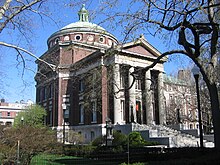
Columbia is home to two pioneers in undergraduate campus radio broadcasting, WKCR-FM and CTV. WKCR, the student run radio station that broadcasts to the Tri-State area, claims to be the oldest FM radio station in the world, owing to the university's affiliation withMajor Edwin Armstrong. The station went operational on July 18, 1939, from a 400-foot antenna tower in Alpine, New Jersey, broadcasting the very first FM transmission in the world. Initially, WKCR wasn't a radio station, but an organization concerned with the technology of radio communications. As membership grew, however, the nascent club turned its efforts to broadcasting. Armstrong helped the students in their early efforts, donating a microphone and turntables when they designed their first makeshift studio in a dorm room. The station has its studios on the second floor of Alfred Lerner Hall on the Morningside campus with its main transmitter tower at 4 Times Square in Midtown Manhattan. Columbia Television (CTV) is the nation's second oldest Student television station and home of CTV News, a weekly live news program produced by undergraduate students.
Debate and Model UN
The Philolexian Society is a literary and debating club founded in 1802, making it the oldest student group at Columbia, as well as the third oldest collegiate literary society in the country. The society annually administers the Joyce Kilmer Bad Poetry Contest. The Columbia Parliamentary Debate Team competes in tournaments around the country as part of the American Parliamentary Debate Association, and hosts both high school and college tournaments on Columbia's campus, as well as public debates on issues affecting the university.

